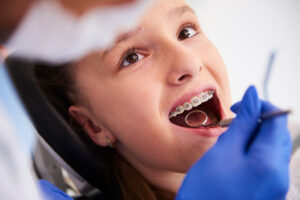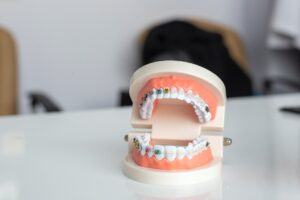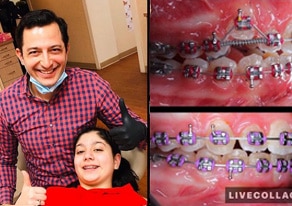Many parents and adults ask the same question—what’s the best age to get braces? The answer isn’t always simple, but timing can make a big difference. Starting treatment at the right stage can lead to faster results, fewer complications, and better long-term outcomes.
Find out how age affects orthodontic treatment, what signs to look for, and what to expect at each stage of life.
Understanding Braces: What They Do and Why Age Matters

Braces are designed to move teeth into better positions. They fix problems like crowding, gaps, bite misalignment, and jaw development issues. But the way the mouth responds to braces can depend heavily on a person’s age.
Here’s why:
- Younger jaws are still growing. This makes it easier to guide the teeth into alignment.
- Treatment is often faster during childhood or early teen years.
- Adults can still get great results, but the process might take longer.
Braces aren’t just about appearances. They also improve how your bite functions and help prevent future dental problems. The sooner issues are addressed, the less complex treatment tends to be.
To compare how age affects treatment, here’s a simple breakdown:
| Age Group | Jaw Development | Treatment Time | Common Benefits |
|---|---|---|---|
| Children (7–10) | Growing rapidly | Short to moderate | Can guide teeth before full eruption |
| Teens (11–17) | Still developing | Moderate | Most common age for full treatment |
| Adults (18+) | Fully developed | Longer in some cases | Cosmetic and functional improvement |
Understanding the role of age sets the stage for knowing when to act—and why early evaluations can matter.
What’s the Best Age to Get Braces?
A lot of people want a clear answer to one question: what’s the best age to get braces? While the ideal age range can vary, most orthodontists agree that the sweet spot falls between 9 and 14 years old.
This stage is important because:
- Most permanent teeth are in place – Braces can move them efficiently without interference from baby teeth.
- The jaw is still developing – This makes it easier to correct bite and alignment issues.
- Shorter treatment times – Since the mouth is more responsive, braces may not need to stay on as long.
- Less chance of needing tooth extractions – Early correction can create space and guide growth.
- More treatment options – Traditional braces, clear brackets, and aligners are all on the table.
Starting braces during this window can also be easier on the patient emotionally. Kids and teens are often surrounded by peers going through the same thing, which helps normalize the experience.
Still, this age range is a general guideline. An orthodontist may recommend treatment earlier or later depending on how the teeth and jaw are developing. Early evaluations are key to finding the right time for each individual.
Braces for Kids: Signs They May Need Early Evaluation
Most orthodontists recommend that children have their first checkup around age 7. That doesn’t mean braces will be needed right away, but it helps catch problems early. Timing can make treatment simpler and more effective.
Here are signs that a child might benefit from an early orthodontic evaluation:
-
Crowded or crooked baby teeth
-
Teeth that come in too early or too late
-
Trouble biting or chewing
-
Mouth breathing
-
Jaw shifting or clicking
-
Thumb sucking past age 5
-
Early or late loss of baby teeth
Catching these signs early can help avoid more serious issues later. In some cases, orthodontists might recommend a two-phase treatment. The first phase can guide jaw growth and make room for incoming teeth. The second phase—often during the 9–14 age range—is when full braces are typically placed.
Parents wondering what’s the best age to get braces for their child should start by scheduling that early consultation. It’s not about rushing treatment—it’s about planning ahead and giving kids the best chance for a healthy, aligned smile.
Teenagers and Braces: Still a Great Time for Treatment
The teenage years are one of the most common times for orthodontic treatment. By this stage, most or all of the permanent teeth have come in. The jaw is still developing, which allows braces to work effectively.
Why teens are often ideal candidates:
- Permanent teeth are fully in place
- Growth can still be guided for bite correction
- Social acceptance is usually higher—many peers also have braces
- Teens tend to understand the importance of keeping up with oral hygiene and appointments
Braces aren’t one-size-fits-all. Teens today have more choices than ever:
- Metal braces – Still the most common and often the most affordable
- Ceramic braces – Less noticeable with tooth-colored brackets
- Clear aligners – Like Invisalign Teen, which can be removed for eating and brushing
For parents still asking what’s the best age to get braces, the teenage window remains a strong option. Treatment at this time can lead to lasting results with fewer complications down the line.
Adults and Braces: Is It Ever Too Late?
More adults are getting braces now than ever before. While treatment may take longer compared to kids or teens, it’s still effective and worth considering.
Common reasons adults choose braces:
- Teeth have shifted over time
- Never had braces as a child
- Jaw or bite problems causing discomfort
- Want to improve appearance and confidence
Benefits of adult orthodontic treatment:
- Clear and discreet options available
- Boost in self-esteem and comfort
- Improved long-term dental health
Potential challenges for adults:
- Slower tooth movement due to fully developed bone
- May require additional procedures like tooth extractions or surgery
- Higher risk of gum issues if oral health isn’t maintained
Many adults ask the same question: what’s the best age to get braces? The answer is that it’s never too late. The right time is when you’re motivated to improve your smile and oral health. With newer options designed for adult lifestyles, starting treatment can be more comfortable and convenient than ever before.
Factors That Influence the Right Age for Braces

Asking what’s the best age to get braces is a good starting point, but the answer depends on more than just age. Every person’s teeth, jaw, and growth patterns are different. Timing is influenced by several factors that your orthodontist will evaluate.
Key things that affect the right age for braces:
- Severity of the issue – Minor crowding can wait; major bite problems may need early care
- Tooth development – Treatment often begins once most permanent teeth have erupted
- Jaw growth – Growth stages can be used to guide alignment for better results
- Oral health – Braces work best when gums and teeth are healthy
- Emotional maturity – Patients need to be able to follow instructions and maintain oral hygiene
An orthodontic consultation is the only way to know for sure. They’ll look at growth patterns, X-rays, and alignment to determine the best timing. For some, early treatment is needed. For others, waiting a little longer may be the better path.
FAQs: What Parents and Patients Commonly Ask
Is age 7 too early for braces?
Not necessarily. Age 7 is a good time for an orthodontic evaluation, not always for treatment. It helps spot issues early and decide if and when braces might be needed.
Can you be too old to get braces?
No. There’s no upper age limit. As long as your teeth and gums are healthy, braces can be effective at any age.
How long does treatment usually take?
Most treatments last between 18 and 24 months. The timeline depends on the complexity of the case and how well instructions are followed.
Does early treatment mean shorter overall treatment time?
Sometimes. Early intervention can correct growth problems and prevent more serious issues later, but it doesn’t always eliminate the need for full braces later on.
Are there alternatives to traditional braces?
Yes. Options include ceramic braces and clear aligners like Invisalign. Your orthodontist will recommend what fits your needs and goals.
Final Thoughts: Timing Is Key to Success
Braces can work well at almost any age, but starting treatment at the right time can make the process easier and more effective. Early evaluations allow orthodontists to catch problems sooner and create a plan that fits each person’s needs.
So, what’s the best age to get braces? For most people, it’s during the early teen years—around ages 9 to 14—but the real answer depends on the individual. Some may benefit from early care, while others may not need treatment until later.
No matter the age, what matters most is getting the right advice at the right time. An orthodontic consultation is the first step.
Book a Consultation with Halabi Orthodontics Today
Choosing the right time to start braces is important—but choosing the right orthodontist matters just as much. At Halabi Orthodontics, we don’t just move teeth. We focus on building confident, lasting smiles through advanced care and thoughtful planning.
Dr. Eli Halabi and his team take every case seriously. From your first visit, you’ll get a personalized experience built around precision, comfort, and results. Using the latest technology, we make each step of your treatment more efficient and more comfortable.
Schedule your consultation with Halabi Orthodontics today and take the first step toward the smile you’ve always wanted.

 CURRENT PATIENT NUMBER
CURRENT PATIENT NUMBER

 What patients are saying
What patients are saying Your smile our passion
Your smile our passion News and Events
News and Events